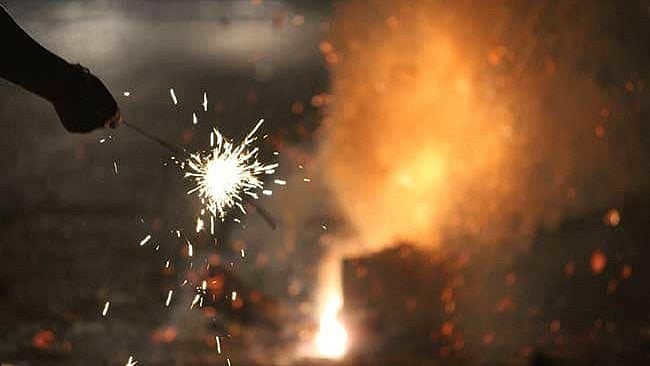Nation
Supreme Court hints at easing Delhi-NCR firecracker ban
SC says absolute firecracker ban in Delhi-NCR “neither practical nor ideal”, hints at allowing limited green crackers

Days before Diwali, the Supreme Court on Friday observed that a complete prohibition on the bursting of firecrackers in Delhi and the National Capital Region (NCR) was “neither practical nor ideal”, as such bans were routinely violated and a balance of competing interests must be struck.
The remarks, signalling a possible relaxation of the existing curbs, came from a Bench comprising Chief Justice of India B.R. Gavai and Justice K. Vinod Chandran, which reserved its verdict on a clutch of petitions seeking permission to manufacture and sell “green” firecrackers in the region.
Appearing for the Centre and the NCR states, solicitor-general Tushar Mehta urged the court to lift the blanket ban that has been in force since 2018, arguing that children should be allowed to burst firecrackers on Diwali and other festivals “without time restrictions”.
“Let the children celebrate for two days — for Diwali, Gurpurab, Christmas. The child inside me is persuading the child in your lordships,” Mehta said, contending that a limited relaxation would not significantly affect air quality.
The Bench questioned the authorities on whether the existing restrictions had made any measurable difference to Delhi’s worsening air quality. “Has the Air Quality Index improved or worsened since 2018? Was the pollution much less then compared to now?” the CJI asked.
In response, the solicitor-general cited data from the Commission for Air Quality Management (CAQM), stating that pollution levels had remained “more or less the same” except during the Covid-19 lockdown when vehicular and industrial activity came to a halt.
Published: undefined
Observing that “extreme orders create problems”, CJI Gavai said the court was seeking a “balanced solution” that would safeguard both environmental concerns and the livelihoods of those dependent on the firecracker industry. “Despite a complete ban, firecrackers continue to be used. Such prohibitions are often evaded in practice. A balance of equities is needed,” he said.
Mehta proposed a “balanced approach” allowing the manufacture and sale of only those firecrackers approved by the National Environmental Engineering Research Institute (NEERI) and the Petroleum and Explosives Safety Organisation (PESO), under strict monitoring.
He suggested that licensed traders alone be permitted to sell such products, with no online sale through e-commerce platforms. Manufacturing units, he added, would be subject to regular inspections, and any violators would face immediate closure.
Senior advocate K. Parameshwar, appearing for green cracker manufacturers, argued that the blanket ban had been imposed in some NCR districts “without consultation” and in contradiction to the Supreme Court’s own 2017 and 2018 rulings which had permitted the controlled use of “eco-friendly” fireworks.
He pointed out that manufacturers had made “huge investments” in NEERI-approved formulations, only to be penalised despite compliance. Another counsel argued that the real contributors to Delhi’s poor air quality were stubble burning and industrial emissions, not festive fireworks.
Lawyer J. Sai Deepak, representing another group of manufacturers, said the industry was already “heavily regulated” and “willing to cooperate fully” with inspections.
CJI Gavai noted that if air quality levels remained largely unchanged, “judicial propriety” required subsequent Benches to consider earlier decisions before issuing fresh orders. “When one Bench has considered all aspects, another cannot simply sit over that,” he remarked.
Published: undefined
The CJI also questioned why the prohibition applied selectively. “Why should there be a ban in only a few districts? Shouldn’t it apply to the entire state of Haryana?” he asked.
The Supreme Court had first intervened in the issue in Arjun Gopal vs Union of India (2017), when it suspended firecracker sales in Delhi-NCR citing alarming pollution levels. However, in subsequent orders, the court permitted the use of green crackers containing reduced emissions and banned laris or joint firecrackers.
In 2018, the apex court allowed bursting of green firecrackers for limited hours — between 8.00 pm and 10.00 pm on Diwali — and authorised only NEERI and PESO-certified products to be manufactured and sold.
On 26 September this year, the court had allowed certified manufacturers to produce green firecrackers but barred their sale in Delhi-NCR without explicit judicial approval. It also asked the Centre to “re-examine” the continuing absolute ban in the region.
Currently, 16 districts across Uttar Pradesh, Rajasthan, and Haryana fall within the NCR along with Delhi — all of which are subject to the restrictions that the court is now reconsidering.
The Bench reserved its order after hearing extensive submissions from the Centre, state governments, manufacturers, environmentalists and the amicus curiae.
While a final verdict is awaited, the court’s latest observations suggest a shift towards moderation — favouring regulation over outright prohibition — as India readies for yet another smog-laden festive season.
With PTI inputs
Published: undefined
Follow us on: Facebook, Twitter, Google News, Instagram
Join our official telegram channel (@nationalherald) and stay updated with the latest headlines
Published: undefined